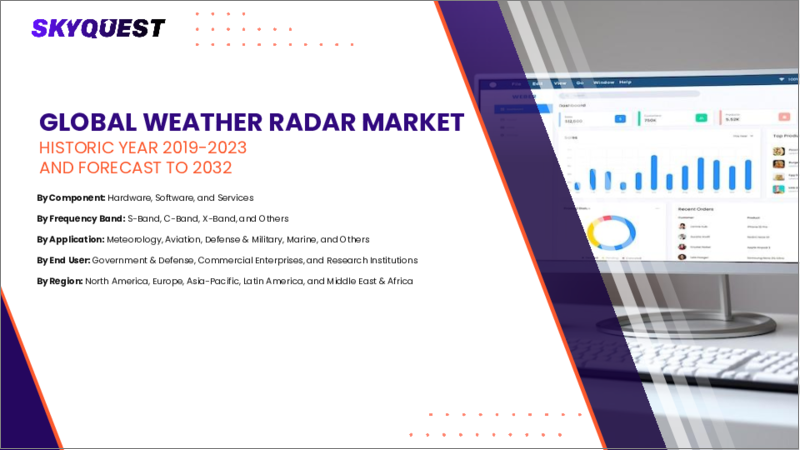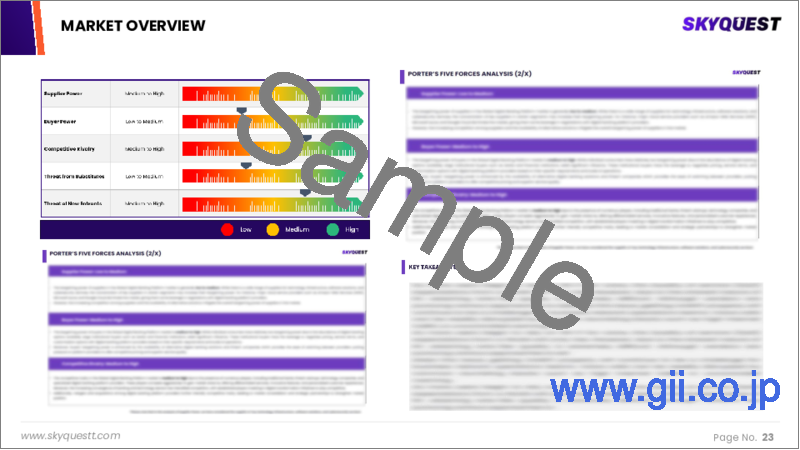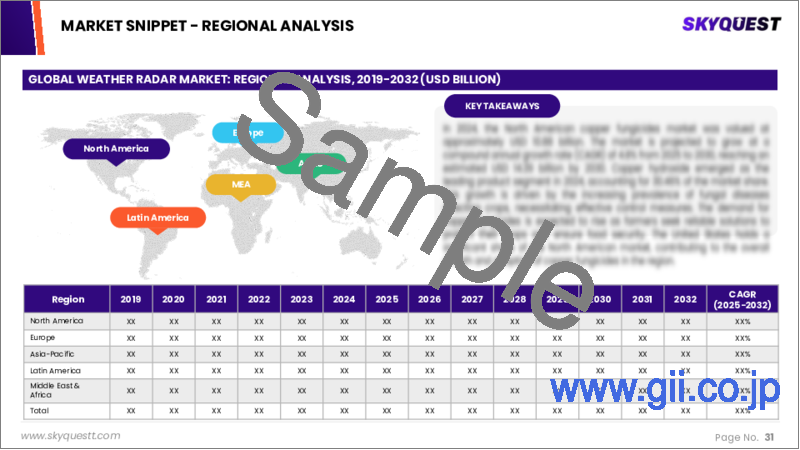|
|
市場調査レポート
商品コード
1622457
気象レーダー市場規模、シェア、成長分析、プラットフォーム別、コンポーネント別、周波数帯別、用途別、地域別 - 産業予測、2024~2031年Weather Radar Market Size, Share, Growth Analysis, By Platform (Airborne, Land-Based), By Component (Transmitter, Antenna), By Frequency Band, By Application, By Region - Industry Forecast 2024-2031 |
||||||
|
|||||||
| 気象レーダー市場規模、シェア、成長分析、プラットフォーム別、コンポーネント別、周波数帯別、用途別、地域別 - 産業予測、2024~2031年 |
|
出版日: 2024年12月22日
発行: SkyQuest
ページ情報: 英文 157 Pages
納期: 3~5営業日
|
全表示
- 概要
- 目次
気象レーダー市場規模は、2023年に13億9,000万米ドルと評価され、2024年の14億8,000万米ドルから2032年には24億6,000万米ドルに成長し、予測期間(2025-2032年)のCAGRは6.5%で成長する見通しです。
気象レーダー技術の市場は、降雨、雲力学、暴風雨の正確な予測を可能にする大気評価における柔軟な機能により成長を遂げています。パルスドップラーレーダーを利用するこれらのシステムは、様々な降水形態の速度と厳しさを測定するために不可欠であり、農業、観光、公共安全、航空などの産業に利益をもたらしています。雷雨、サイクロン、冬の嵐などの自然災害の発生率が上昇しているため、堅牢な気象予測ツールの需要が高まっています。さらに、世界の交通量の増加が航空レーダー・システムの必要性をさらに高めています。しかし、代替技術の普及が市場拡大の課題となっており、業界関係者はこの進化する情勢の中で競争上の優位性を維持するために、革新的な製品提供の強化に取り組んでいます。
目次
イントロダクション
- 調査の目的
- 調査範囲
- 定義
調査手法
- 情報調達
- 二次データと一次データの方法
- 市場規模予測
- 市場の前提条件と制限
エグゼクティブサマリー
- 世界市場の見通し
- 供給と需要の動向分析
- セグメント別機会分析
市場力学と見通し
- 市場概要
- 市場規模
- 市場力学
- 促進要因と機会
- 抑制要因と課題
- ポーターの分析
主な市場の考察
- 重要成功要因
- 競合の程度
- 主な投資機会
- 市場エコシステム
- 市場の魅力指数(2024年)
- PESTEL分析
- マクロ経済指標
- バリューチェーン分析
- 価格分析
- 技術の進歩
- 規制情勢
気象レーダー市場規模:プラットフォーム別
- 市場概要
- 航空
- 陸上ベース
気象レーダー市場規模:コンポーネント別
- 市場概要
- 送信機
- アンテナ
- 受信機
- 画面
- その他
気象レーダー市場規模:周波数帯域別
- 市場概要
- Cバンド
- Sバンド
- Xバンド
- その他
気象レーダー市場規模:用途別
- 市場概要
- 気象学と水文学
- 航空産業
- 軍用
気象レーダー市場規模
- 北米
- 米国
- カナダ
- 欧州
- ドイツ
- スペイン
- フランス
- 英国
- イタリア
- その他欧州地域
- アジア太平洋地域
- 中国
- インド
- 日本
- 韓国
- その他アジア太平洋地域
- ラテンアメリカ
- ブラジル
- その他ラテンアメリカ地域
- 中東・アフリカ
- GCC諸国
- 南アフリカ
- その他中東・アフリカ
競合情報
- 上位5社の比較
- 主要企業の市場ポジショニング(2024年)
- 主な市場企業が採用した戦略
- 市場の最近の動向
- 企業の市場シェア分析(2024年)
- 主要企業の企業プロファイル
- 会社概要
- 製品ポートフォリオ分析
- セグメント別シェア分析
- 収益の前年比比較(2022-2024)
主要企業プロファイル
- Honeywell International Inc.(USA)
- Enterprise Electronics Corporation(EEC)(USA)
- Selex ES GmbH(Germany)
- EWR Weather Radar(USA)
- Beijing Metstar Radar Co., Ltd.(China)
- Leonardo S.p.A.(Italy)
- Vaisala Oyj(Finland)
- Toshiba Corporation(Japan)
- Furuno Electric Co., Ltd.(Japan)
- Mitsubishi Electric Corporation(Japan)
- China Electronics Technology Group Corporation(CETC)(China)
- GAMIC mbH(Germany)
- Baron Services, Inc.(USA)
- Raytheon Technologies Corporation(USA)
- Lockheed Martin Corporation(USA)
- Northrop Grumman Corporation(USA)
- Rockwell Collins, Inc.(USA)
- Telephonics Corporation(USA)
- Indra Sistemas, S.A.(Spain)
- Thales Group(France)
結論と推奨事項
Weather Radar Market size was valued at USD 1.39 Billion in 2023 and is poised to grow from USD 1.48 Billion in 2024 to USD 2.46 Billion by 2032, growing at a CAGR of 6.5% during the forecast period (2025-2032).
The market for weather radar technology is experiencing growth due to its flexible capabilities in atmospheric assessment, enabling accurate predictions of rainfall, cloud dynamics, and storm movement. Utilizing pulse-doppler radar, these systems are essential for gauging the velocity and severity of various precipitation forms, benefiting industries such as agriculture, tourism, public safety, and aviation. The rising incidence of natural disasters like thunderstorms, cyclones, and winter storms amplifies the demand for robust weather forecasting tools. Moreover, global traffic increases further elevate the need for airborne radar systems. However, the proliferation of alternative technologies poses a challenge to market expansion, prompting industry stakeholders to innovate and enhance their offerings to maintain competitive advantages in this evolving landscape.
Top-down and bottom-up approaches were used to estimate and validate the size of the Weather Radar market and to estimate the size of various other dependent submarkets. The research methodology used to estimate the market size includes the following details: The key players in the market were identified through secondary research, and their market shares in the respective regions were determined through primary and secondary research. This entire procedure includes the study of the annual and financial reports of the top market players and extensive interviews for key insights from industry leaders such as CEOs, VPs, directors, and marketing executives. All percentage shares split, and breakdowns were determined using secondary sources and verified through Primary sources. All possible parameters that affect the markets covered in this research study have been accounted for, viewed in extensive detail, verified through primary research, and analyzed to get the final quantitative and qualitative data.
Weather Radar Market Segmental Analysis
Global Weather Radar Market is segmented by platform, component, frequency band, application and region. Based on platform, the market is segmented into airborne and land-based. Based on component, the market is segmented into transmitter, antenna, receiver, display and others. Based on frequency band, the market is segmented into C-Band, S-Band, X-Band and others. Based on application, the market is segmented into meteorology & hydrology, aviation industry and military. Based on region, the market is segmented into North America, Europe, Asia Pacific, Latin America and Middle East & Africa.
Driver of the Weather Radar Market
The Weather Radar market is significantly driven by the increasing occurrences of turbulence and severe weather events that pose risks to passenger safety during flights. Recent incidents have highlighted the dangers of hailstorms damaging aircraft, emphasizing the necessity for accurate weather detection. With climate change contributing to extreme weather patterns and deteriorating infrastructure, the demand for reliable weather monitoring systems has skyrocketed. Countries like Australia are investing in expanding their weather radar networks to better predict severe conditions, thereby enhancing flight safety. Furthermore, as the aviation industry sees a surge in aircraft deliveries due to growing air travel demand, the integration of advanced airborne radar systems in new aircraft is essential, propelling market growth.
Restraints in the Weather Radar Market
The weather radar market faces significant constraints primarily due to its reliance on reflecting beams off water droplets in the atmosphere, which limits its effectiveness. This technology only detects liquid forms of precipitation, rendering it ineffective against other weather phenomena such as ice crystals, dry hail, dry snow, and sandstorms. Moreover, the reflectivity measurements can misrepresent the severity of conditions, particularly in thunderstorms where water droplet intensity decreases with altitude. As a result, users are increasingly turning to alternative technologies that provide more accurate meteorological data, which may stifle the growth of the weather radar market as demand shifts toward these advanced solutions.
Market Trends of the Weather Radar Market
The Weather Radar market is witnessing a significant trend towards advanced mobile radar systems, exemplified by the recent launch of the AN/TPY(V)1 by the US. This innovative technology is set to gain traction due to its capability to monitor a range of aerial threats, including drones, fifth-generation aircraft, and hypersonic missiles. Its software-defined architecture allows for rapid upgrades, enhancing operational readiness in dynamic and contested environments. This agility in updating functionalities within hours or minutes, as opposed to conventional radars' longer timelines, positions mobile weather radars as a key player in modern warfare strategies, driving demand and innovation in the industry.
Table of Contents
Introduction
- Objectives of the Study
- Scope of the Report
- Definitions
Research Methodology
- Information Procurement
- Secondary & Primary Data Methods
- Market Size Estimation
- Market Assumptions & Limitations
Executive Summary
- Global Market Outlook
- Supply & Demand Trend Analysis
- Segmental Opportunity Analysis
Market Dynamics & Outlook
- Market Overview
- Market Size
- Market Dynamics
- Drivers & Opportunities
- Restraints & Challenges
- Porters Analysis
- Competitive rivalry
- Threat of substitute
- Bargaining power of buyers
- Threat of new entrants
- Bargaining power of suppliers
Key Market Insights
- Key Success Factors
- Degree of Competition
- Top Investment Pockets
- Market Ecosystem
- Market Attractiveness Index, 2024
- PESTEL Analysis
- Macro-Economic Indicators
- Value Chain Analysis
- Pricing Analysis
- Technological Advancement
- Regulatory Landscape
Global Weather Radar Market Size by Platform & CAGR (2025-2032)
- Market Overview
- Airborne
- Land-Based
Global Weather Radar Market Size by Component & CAGR (2025-2032)
- Market Overview
- Transmitter
- Antenna
- Receiver
- Display
- Others
Global Weather Radar Market Size by Frequency Band & CAGR (2025-2032)
- Market Overview
- C-Band
- S-Band
- X-Band
- Others
Global Weather Radar Market Size by Application & CAGR (2025-2032)
- Market Overview
- Meteorology & Hydrology
- Aviation Industry
- Military
Global Weather Radar Market Size & CAGR (2025-2032)
- North America (Platform, Component, Frequency Band, Application)
- US
- Canada
- Europe (Platform, Component, Frequency Band, Application)
- Germany
- Spain
- France
- UK
- Italy
- Rest of Europe
- Asia Pacific (Platform, Component, Frequency Band, Application)
- China
- India
- Japan
- South Korea
- Rest of Asia-Pacific
- Latin America (Platform, Component, Frequency Band, Application)
- Brazil
- Rest of Latin America
- Middle East & Africa (Platform, Component, Frequency Band, Application)
- GCC Countries
- South Africa
- Rest of Middle East & Africa
Competitive Intelligence
- Top 5 Player Comparison
- Market Positioning of Key Players, 2024
- Strategies Adopted by Key Market Players
- Recent Developments in the Market
- Company Market Share Analysis, 2024
- Company Profiles of All Key Players
- Company Details
- Product Portfolio Analysis
- Company's Segmental Share Analysis
- Revenue Y-O-Y Comparison (2022-2024)
Key Company Profiles
- Honeywell International Inc. (USA)
- Company Overview
- Business Segment Overview
- Financial Updates
- Key Developments
- Enterprise Electronics Corporation (EEC) (USA)
- Company Overview
- Business Segment Overview
- Financial Updates
- Key Developments
- Selex ES GmbH (Germany)
- Company Overview
- Business Segment Overview
- Financial Updates
- Key Developments
- EWR Weather Radar (USA)
- Company Overview
- Business Segment Overview
- Financial Updates
- Key Developments
- Beijing Metstar Radar Co., Ltd. (China)
- Company Overview
- Business Segment Overview
- Financial Updates
- Key Developments
- Leonardo S.p.A. (Italy)
- Company Overview
- Business Segment Overview
- Financial Updates
- Key Developments
- Vaisala Oyj (Finland)
- Company Overview
- Business Segment Overview
- Financial Updates
- Key Developments
- Toshiba Corporation (Japan)
- Company Overview
- Business Segment Overview
- Financial Updates
- Key Developments
- Furuno Electric Co., Ltd. (Japan)
- Company Overview
- Business Segment Overview
- Financial Updates
- Key Developments
- Mitsubishi Electric Corporation (Japan)
- Company Overview
- Business Segment Overview
- Financial Updates
- Key Developments
- China Electronics Technology Group Corporation (CETC) (China)
- Company Overview
- Business Segment Overview
- Financial Updates
- Key Developments
- GAMIC mbH (Germany)
- Company Overview
- Business Segment Overview
- Financial Updates
- Key Developments
- Baron Services, Inc. (USA)
- Company Overview
- Business Segment Overview
- Financial Updates
- Key Developments
- Raytheon Technologies Corporation (USA)
- Company Overview
- Business Segment Overview
- Financial Updates
- Key Developments
- Lockheed Martin Corporation (USA)
- Company Overview
- Business Segment Overview
- Financial Updates
- Key Developments
- Northrop Grumman Corporation (USA)
- Company Overview
- Business Segment Overview
- Financial Updates
- Key Developments
- Rockwell Collins, Inc. (USA)
- Company Overview
- Business Segment Overview
- Financial Updates
- Key Developments
- Telephonics Corporation (USA)
- Company Overview
- Business Segment Overview
- Financial Updates
- Key Developments
- Indra Sistemas, S.A. (Spain)
- Company Overview
- Business Segment Overview
- Financial Updates
- Key Developments
- Thales Group (France)
- Company Overview
- Business Segment Overview
- Financial Updates
- Key Developments






